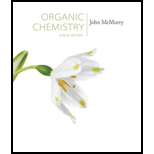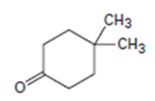
Organic Chemistry
9th Edition
ISBN: 9781305080485
Author: John E. McMurry
Publisher: Cengage Learning
expand_more
expand_more
format_list_bulleted
Concept explainers
Question
Chapter 13.SE, Problem 36AP
Interpretation Introduction
a)

Interpretation:
To predict the signals of the following molecules in its 1H and 13C spectra.
Interpretation Introduction
b)

Interpretation:
To predict the signals of the following molecules in its 1H and 13C spectra.
Interpretation Introduction
c)

Interpretation:
To predict the signals of the following molecules in its 1H and 13C spectra.
Expert Solution & Answer
Trending nowThis is a popular solution!

Students have asked these similar questions
What is the total energy cost associated with the compound below adopting the shown conformation?
CH3
HH
DH
CH3
ΗΝ,
Draw Final Product
C
cyclohexanone
pH 4-5
Edit Enamine
H3O+
CH3CH2Br
THF, reflux
H
Edit Iminium Ion
How many hydrogen atoms are connected to the indicated carbon atom?
Chapter 13 Solutions
Organic Chemistry
Ch. 13.1 - Prob. 1PCh. 13.1 - Prob. 2PCh. 13.2 - Prob. 3PCh. 13.3 - The following 1H NMR peaks were recorded on a...Ch. 13.3 - When the 1Η NMR spectrum of acetone, CH3COCH3, is...Ch. 13.4 - Each of the following compounds has a single 1H...Ch. 13.4 - Identify the different types of protons in the...Ch. 13.5 - How many peaks would you expect in the 1H NMR...Ch. 13.6 - Predict the splitting patterns you would expect...Ch. 13.6 - Draw structures for compounds that meet the...
Ch. 13.6 - The integrated 1H NMR spectrum of a compound of...Ch. 13.7 - Identify the indicated sets of protons as...Ch. 13.7 - How many kinds of electronically nonequivalent...Ch. 13.7 - How many absorptions would you expect (S)-malate,...Ch. 13.8 - 3-Bromo-1-phenyl-1-propene shows a complex NMR...Ch. 13.9 - How could you use 1H NMR to determine the...Ch. 13.11 - Prob. 17PCh. 13.11 - Propose structures for compounds that fit the...Ch. 13.11 - Prob. 19PCh. 13.12 - Prob. 20PCh. 13.12 - Prob. 21PCh. 13.12 - Prob. 22PCh. 13.13 - Prob. 23PCh. 13.SE - Into how many peaks would you expect the 1H NMR...Ch. 13.SE - How many absorptions would you expect the...Ch. 13.SE - Sketch what you might expect the 1H and 13C NMR...Ch. 13.SE - How many electronically nonequivalent kinds of...Ch. 13.SE - Identify the indicated protons in the following...Ch. 13.SE - Prob. 29APCh. 13.SE - Prob. 30APCh. 13.SE - When measured on a spectrometer operating at 200...Ch. 13.SE - Prob. 32APCh. 13.SE - Prob. 33APCh. 13.SE - How many types of nonequivalent protons are...Ch. 13.SE - The following compounds all show a single line in...Ch. 13.SE - Prob. 36APCh. 13.SE - Propose structures for compounds with the...Ch. 13.SE - Predict the splitting pattern for each kind of...Ch. 13.SE - Predict the splitting pattern for each kind of...Ch. 13.SE - Identify the indicated sets of protons as...Ch. 13.SE - Identify the indicated sets of protons as...Ch. 13.SE - The acid-catalyzed dehydration of...Ch. 13.SE - How could you use 1H NMR to distinguish between...Ch. 13.SE - Propose structures for compounds that fit the...Ch. 13.SE - Propose structures for the two compounds whose 1H...Ch. 13.SE - Prob. 46APCh. 13.SE - How many absorptions would you expect to observe...Ch. 13.SE - Prob. 48APCh. 13.SE - How could you use 1H and 13C NMR to help...Ch. 13.SE - How could you use 1H NMR, 13C NMR, and IR...Ch. 13.SE - Assign as many resonances as you can to specific...Ch. 13.SE - Assume that you have a compound with the formula...Ch. 13.SE - The compound whose 1H NMR spectrum is shown has...Ch. 13.SE - The compound whose 1H NMR spectrum is shown has...Ch. 13.SE - Propose structures for compounds that fit the...Ch. 13.SE - Long-range coupling between protons more than two...Ch. 13.SE - The 1H and 13C NMR spectra of compound A, C8H9Br,...Ch. 13.SE - Propose structures for the three compounds whose...Ch. 13.SE - The mass spectrum and 13C NMR spectrum of a...Ch. 13.SE - Compound A, a hydrocarbon with M+=96 in its mass...Ch. 13.SE - Propose a structure for compound C, which has...Ch. 13.SE - Prob. 62GPCh. 13.SE - Propose a structure for compound E, C7H12O2, which...Ch. 13.SE - Compound F, a hydrocarbon with M+=96 in its mass...Ch. 13.SE - 3-Methyl-2-butanol has five signals in its 13C NMR...Ch. 13.SE - A 13C NMR spectrum of commercially available...Ch. 13.SE - Carboxylic acids (RCO2H) react with alcohols (ROH)...Ch. 13.SE - Prob. 68GPCh. 13.SE - The proton NMR spectrum is shown for a compound...Ch. 13.SE - The proton NMR spectrum of a compound with the...Ch. 13.SE - The proton NMR spectrum is shown for a compound...
Knowledge Booster
Learn more about
Need a deep-dive on the concept behind this application? Look no further. Learn more about this topic, chemistry and related others by exploring similar questions and additional content below.Similar questions
- Identify the compound with the longest carbon - nitrogen bond. O CH3CH2CH=NH O CH3CH2NH2 CH3CH2C=N CH3CH=NCH 3 The length of all the carbon-nitrogen bonds are the samearrow_forwardIdentify any polar covalent bonds in epichlorohydrin with S+ and 8- symbols in the appropriate locations. Choose the correct answer below. Η H's+ 6Η Η Η Η Η Ηδ Η Ο Ο HH +Η Η +Η Η Η -8+ CIarrow_forwardH H:O::::H H H HH H::O:D:D:H HH HH H:O:D:D:H .. HH H:O:D:D:H H H Select the correct Lewis dot structure for the following compound: CH3CH2OHarrow_forward
- Rank the following compounds in order of decreasing boiling point. ннннн -С-С-Н . н-с- ННННН H ΗΤΗ НННН TTTĪ н-с-с-с-с-о-н НННН НН C' Н н-с-с-с-с-н НН || Ш НННН H-C-C-C-C-N-H ННННН IVarrow_forwardRank the following compounds in order of decreasing dipole moment. |>||>||| ||>|||>| |>|||>|| |||>||>| O ||>>||| H F H F H c=c || H c=c F F IIIarrow_forwardchoose the description that best describes the geometry for the following charged species ch3-arrow_forward
- Why isn't the ketone in this compound converted to an acetal or hemiacetal by the alcohol and acid?arrow_forwardWhat is the approximate bond angle around the nitrogen atom? HNH H Harrow_forwardOH 1. NaOCH2CH3 Q 2. CH3CH2Br (1 equiv) H3O+ Select to Draw 1. NaOCH2 CH3 2. CH3Br (1 equiv) heat Select to Edit Select to Drawarrow_forward
- Complete and balance the following half-reaction in acidic solution. Be sure to include the proper phases for all species within the reaction. S₂O₃²⁻(aq) → S₄O₆²⁻(aq)arrow_forwardQ Select to Edit NH3 (CH3)2CHCI (1 equiv) AICI 3 Select to Draw cat. H2SO4 SO3 (1 equiv) HO SOCl2 pyridine Select to Edit >arrow_forwardComplete and balance the following half-reaction in basic solution. Be sure to include the proper phases for all species within the reaction. Zn(s) → Zn(OH)₄²⁻(aq)arrow_forward
arrow_back_ios
SEE MORE QUESTIONS
arrow_forward_ios
Recommended textbooks for you

 Organic Chemistry: A Guided InquiryChemistryISBN:9780618974122Author:Andrei StraumanisPublisher:Cengage Learning
Organic Chemistry: A Guided InquiryChemistryISBN:9780618974122Author:Andrei StraumanisPublisher:Cengage Learning Organic ChemistryChemistryISBN:9781305580350Author:William H. Brown, Brent L. Iverson, Eric Anslyn, Christopher S. FootePublisher:Cengage Learning
Organic ChemistryChemistryISBN:9781305580350Author:William H. Brown, Brent L. Iverson, Eric Anslyn, Christopher S. FootePublisher:Cengage Learning


Organic Chemistry: A Guided Inquiry
Chemistry
ISBN:9780618974122
Author:Andrei Straumanis
Publisher:Cengage Learning

Organic Chemistry
Chemistry
ISBN:9781305580350
Author:William H. Brown, Brent L. Iverson, Eric Anslyn, Christopher S. Foote
Publisher:Cengage Learning